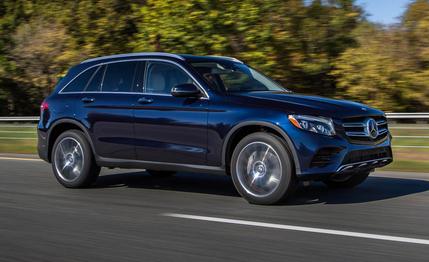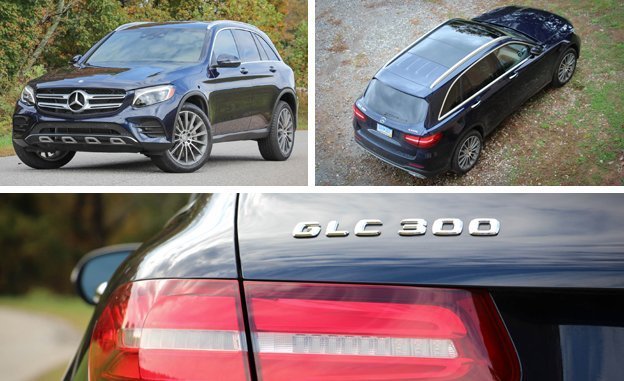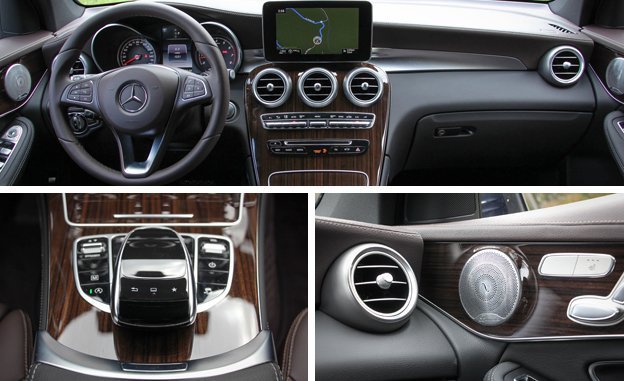
 First Drive Review
First Drive Review
We got our first taste of the all-new Mercedes-Benz GLC-class this summer in Europe, where we briefly piloted a few GLC models powered by a torquey diesel and a not-so-torquey, 211-hp four-cylinder gas engine. The former engine is poised to come here later next year, while the latter will not come here at all. Missing was the GLC300 with its 241-hp four-cylinder and attendant nine-speed automatic, the model that matters most to us in the U.S. We’ve just now spent the better part of two days with that version, traversing the roads around Mercedes’ new Atlanta headquarters, from congested downtown to rural northern Georgia byways, and we can say that the GLC300 felt right at home, in more ways than one.
Visually and dimensionally, the GLC-class takes its rightful place in the Mercedes-Benz lineup below the larger GLE-class. Like the C-class with which the GLC shares much of its underpinnings, this crossover has a long nose with a broad grille, stern headlamps, and a contoured hood. Unlike its sedan counterpart, the GLC’s body does not droop toward the rear but rather stays parallel with the ground from stem to stern, giving it a proper SUV countenance. (A low-roofed coupe model will make a more-aggressive style statement when it arrives sometime next year.) The full raft of C-class features are available, including full-LED lighting, Sport package regalia, and wheel sizes ranging from 18 to 20 inches. Even better, the GLC is claimed to weigh nearly 200 pounds less than its predecessor, the GLK-class.


The GLC’s cabin design, equipment, and materials create a virtual clone of the swank C-class—a very good thing indeed—although with three inches more width, a more upright windshield, and a higher ceiling, it feels far more spacious. Mercedes is particularly proud of the GLC’s vast storage abilities (six water bottles can be secured in the front seating area alone), including a 16-percent increase in cargo space over the GLK. The rear seat seems limo-like compared with those of both the current C-class and the old GLK, and the panoramic sunroof gives it an airy feel indeed.
But we knew all that from our first encounter. What we really came to find out is how well the U.S.-spec four-banger can handle our roads and traffic. In the end, while we’re always up for more power—an AMG Sport model is reportedly on the way, likely to share the C450 AMG’s 362-hp turbo V-6—we are inclined to say that the direct-injected 2.0-liter four strikes exactly the right balance between power and efficiency. The GLC300 effectively replaces the V-6–powered GLK350. The turbo four’s 241 horsepower is down markedly from the GLK350’s 302 ponies, but torque is the same at 273 lb-ft, all of which is available anywhere between 1300 and 4000 rpm. The four-pot’s power delivery is effortless and smooth, and Mercedes thinks it will be even quicker than the GLK while going 20 percent farther on a gallon of gas. The new nine-speed automatic, however, exhibited some rather unbecoming behavior, most noticeably in the form of a mild thunk during throttle uptake when accelerating in slow-and-go traffic.
The lack of smoothness might be less noteworthy had it not occurred in all settings of the Dynamic Select system, which comes standard on all GLC300s. As in most other models with Dynamic Select, the technology adjusts steering effort, throttle response, and shift points among Comfort, Sport, Sport+, Eco, and Individual programs. Sport not surprisingly was our preference in town; left in Comfort or Eco, the engine feels rather flat-footed, while Sport+ can be a bit too high-strung for the daily slog.


We previously stated that the GLC-class handles “like a C-class on stilts.” Key words there: on stilts. The GLC300 is a crossover, after all, and its higher perch, additional mass, and slight body roll won’t let you forget it. The steering is precise and beautifully weighted at all speeds in Comfort or Sport modes. Sport+ brings some additional weight but no more feel even under full cornering load. As with the C, the GLC’s brakes are progressive, with good feel and quick responses without being too grabby.
Ride quality, however, seems even creamier than in the C-class, and that was with the standard steel springs. Air suspension is optional, but we’d pocket the extra $1900 given how nicely the standard setup rides. The exception: If we regularly traversed deep ruts or unplowed winter roads, the air springs’ ability to raise up the body might justify the price.
Speaking of off-roading, the available 4MATIC all-wheel-drive system has been reengineered for the GLC and features a 45/55 front-to-rear torque split. While Mercedes says it is optimized for on-road use, its spokespeople claim it should do well off-road, too. We’ll have to take their word for it, as we didn’t get a chance to do any off-roading beyond hopping a curb in search of a photo spot. Most owners likely will do even less.
Despite its advanced age, dated styling, and barrage of newer competitors, the outgoing GLK-class sold nearly twice as well in its final full year than it did in its first two, so the GLC300 will have the wind at its back when it hits dealerships this December. Prices increase by $1050 from GLK levels to $39,875 for the rear-driver and $41,875 for the 4MATIC—putting them right on top of the BMW X3 and the Audi Q5. Mercedes points out that about $3K worth of added equipment has been folded into the deal, not to mention the new model’s added refinement, style, and space. With all that on its side, we expect that the GLC300 will find itself right at home in many garages in suburban Atlanta and beyond.